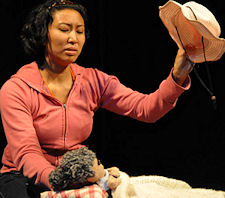catherine hernandez
Sulong Theatre’s Eating With Lola, which played as part of the Next Stage Theatre Festival, centers on a young woman, Grace, and her relationship with her sometimes cantankerous, sickly grandmother (or Lola in Filipino), Ruffina, for whom she acts as caretaker. The story unfolds in a predictable manner, for as Ruffina opens up about her past, Grace is able to delve into a richer understanding of why she is so particular about her food and her empathy helps the two of them reach a state of eventual peace.
What makes this play so unique is the way that writer and performer Catherine Hernandez has chosen to dramatize this story. Hernandez plays Grace, but all the other characters in the play are dramatized using puppetry directed with beautiful fluidity by Ann Powell. Yet, not even the puppetry is conventional, Ruffina looks like a little Beanie Baby doll of an older Filipino woman, but all the other characters are imaginatively suggested using every day props such as a sunhat, sunglasses and a shoe. Hernandez gives all the characters great specificity of voice and manages to infuse her Lola puppet with remarkable amounts of emotion and gravity, especially when she drops her beloved spoon and struggles to bend down to retrieve it and then, heartbreakingly, struggles even more vigorously to return to her bed. It is amazing how captivating and gruelling watching a small stuffed doll simulating pain can be.
Like a very tiny Sophia Petrillo, Ruffina takes us back to Manila in 1944, a time when as a High School student her family’s poverty forced her to have to work as a cook for the wife of one of her teachers. It was through her relationship with this family that she met the revolutionary Manuel Sanchez, who she would fall in love with and eventually marry saying, “I knew I could feed this man for a long time.” The stories are simple and sweet, but Hernandez draws the audience in. Actually, the only thing about this show that I found disappointing was that I wanted to know so much more about these characters. I had so many more questions. The action jumps between sometime around 1950, when Ruffina and her family move to California, to, I’m assuming based on a Little Mermaid reference, somewhere circa 1989, and I was so curious about what adventures had been left out between those dates. I also wondered why Grace had been left as the sole caretaker of her grandmother, when it had been specified that not only was her mother around, but that she would also have had aunts and uncles. I wondered where they were and how they fit into the story.
Beyond that, Hernandez’s play is delightful food for the soul.







